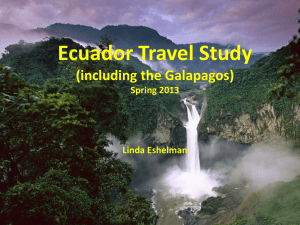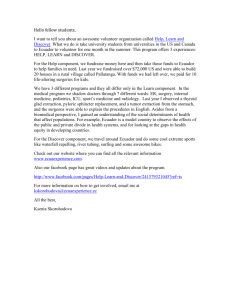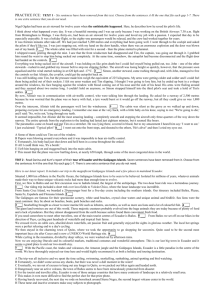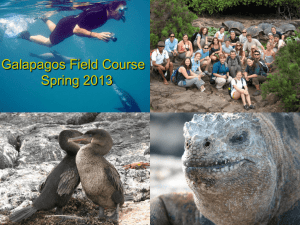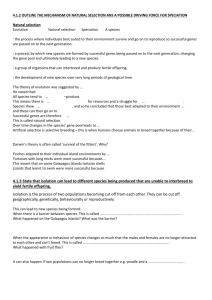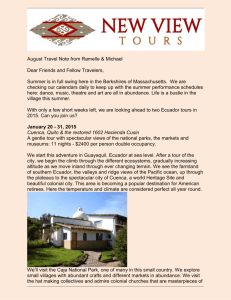Jazmin Cristina Harb A. Topic: Ecuador and its regions. General
advertisement
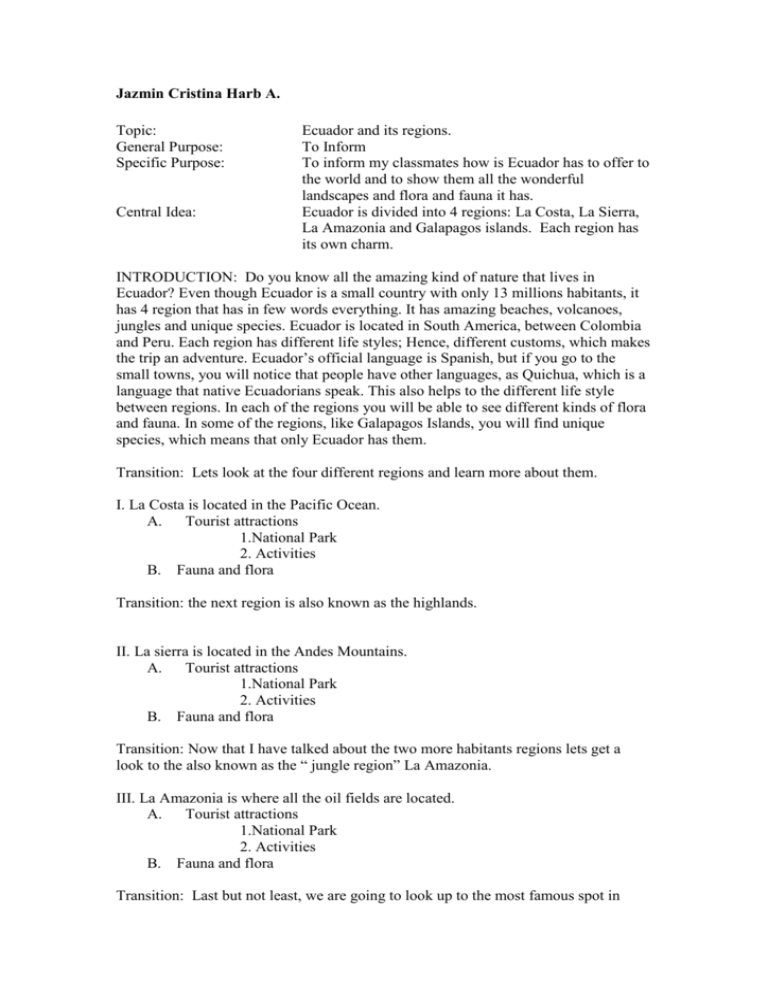
Jazmin Cristina Harb A. Topic: General Purpose: Specific Purpose: Central Idea: Ecuador and its regions. To Inform To inform my classmates how is Ecuador has to offer to the world and to show them all the wonderful landscapes and flora and fauna it has. Ecuador is divided into 4 regions: La Costa, La Sierra, La Amazonia and Galapagos islands. Each region has its own charm. INTRODUCTION: Do you know all the amazing kind of nature that lives in Ecuador? Even though Ecuador is a small country with only 13 millions habitants, it has 4 region that has in few words everything. It has amazing beaches, volcanoes, jungles and unique species. Ecuador is located in South America, between Colombia and Peru. Each region has different life styles; Hence, different customs, which makes the trip an adventure. Ecuador’s official language is Spanish, but if you go to the small towns, you will notice that people have other languages, as Quichua, which is a language that native Ecuadorians speak. This also helps to the different life style between regions. In each of the regions you will be able to see different kinds of flora and fauna. In some of the regions, like Galapagos Islands, you will find unique species, which means that only Ecuador has them. Transition: Lets look at the four different regions and learn more about them. I. La Costa is located in the Pacific Ocean. A. Tourist attractions 1.National Park 2. Activities B. Fauna and flora Transition: the next region is also known as the highlands. II. La sierra is located in the Andes Mountains. A. Tourist attractions 1.National Park 2. Activities B. Fauna and flora Transition: Now that I have talked about the two more habitants regions lets get a look to the also known as the “ jungle region” La Amazonia. III. La Amazonia is where all the oil fields are located. A. Tourist attractions 1.National Park 2. Activities B. Fauna and flora Transition: Last but not least, we are going to look up to the most famous spot in Ecuador. The Galapagos Islands. IV. Galapagos Islands: the home of evolution. A. Tourist attractions 1.National Park 2. Activities B. Fauna and flora Transition: Finally, after I have talked about the four main regions I will conclude saying the following: CONCLUSION: Ecuador is an amazing country that has too many things to offer to everyone who visits it. Its four regions have many enriched things to offer to the world. Some of them are considered as “ Patrimonio cultural de la humanidad”, which means that is a Cultural Heritage. Hopefully, after my speech everyone be more aware of how amazing Ecuador is and be willing to go and visit it. As I said before, each of the regions, Costa, Sierra, La Amazonia and Galapagos islands have unique things, so I strongly recommend you to go and visit each of the regions while you are there. You will fall in love with every of the species you see over there. REFERENCES “Republic of Ecuador.” ProQuest LLC ad Brigham Young University, 2010. www.culturegrams.com. Retrieved February 2nd 2011. (Proquest LLC and Brigham Young University) Background note: Ecuador. U.S department of state 2010. www.state.gov/r/pa/ei/bgn/35761.htm . Retrieved February 12th. 2011. (U.S department of state) “ Ecuador”. The Galapagos islands. nterKnowledge Corp. 2006. www.geographia.com/ecuador/galislands.htm. Retrieved February 15th. 2011. “Ecuador”. The Andes. Hipecuador.com 2006. www.hipecuador.com Retrieved February 16th. 2011 “ Ecuador”. Maquinet corp. 1997-2010. www.ecuadorthingstodo.com retrieved February 16th. 2011 COAST A) There is only one national park in the entire region. Its name is Bosque Protector Cerro Blanco. It is located in Guayaquil. This national park is around 8, 645 acres and protects some 3,500 dry forests; it gives den to over 200 bird species and plenty of mammals. For example: howler, monkeys, kinkajous and jaguars. It is open daily from 8:30 to 4: 30 and the admission fee is 5 for adults and 2 for students or kids. There are so many places where you can go and have so much fun. The best waves are in Montanita., with waves that reach three meters in height. That is why a lot of international surfers go there to surf and train. Yet, one doesn’t have to surf you can also have a great time meeting so many international and national people that go there to have fun and exercise themselves. The second major beach is canoa, which is located in Manabi. It is also a beach where lots of surfers go for the waves. If surfing is not your thing you may go to Punta Blanca, Punta carnero, or manglaralto, where you can find fishing or boating opportunities. Salinas, which is the beach where more of the Ecuadorian people visit every holiday as Jet Ski, windsurf and dive opportunities. B) The Ecuadorian coast counts with amazing beaches and with extraordinary mangrove swamps. These kinds of swamps are able to grow in salt water. They are the home of a lot of animals such as fish, mollusk, crustacean and other invertebrates’ animals, which live on their roots. It also gives den to animals such as: pelicans, frigates and other sea birds. HIGHLANDS A) 1. El angel colloquial reserve is the main national park the highlands have according to hip.ecuador.com. It is located in Carchi and it counts with 38831,23 acres. It mainly consists of grassland, that because is located in a high altitude it is able to retain large quantities of water. This grassland is known as paramos in Ecuador. The strange flora that grows up over there is called espeletia, which is a giant plant around three meters high and it is very similar to the sunflower. 2. Things you can do in La sierra are hiking the volcanoes or mountains, trout fishing, the Andes camping, horseback riding and of course rating. For instance, Cajas offers you an extensive box canyon. The podocarpus national park offers a large range of orchids, romerillos and the rare podocarpus tree. Horseback riding and hiking are activities you might do near the lakes of los compadres or picachos del condor. Vilcamba or anywhere In Loja is the best place to od any river sport such as rafting. However, if you are more into agriculture, you should visit Yunguilla valley near Cuenca, where are located most of the farms with sugar plantations, sugar mills, citrus fruits, coffee, tomatoes, potatoes, wheat, and rice. B) The highlands count with a wide and amazing fauna. Some unique species are Tremarctos ornatus, the paramo deer, the American puma and the paramo jaguar. It is also home of so many birds species such as: Monte hen, torrent duck, Andean turkey, band- tailed pigeon, rose crowned parakeet, blue fronted parrotlet, green parakeet, golden headed, green monitor, the amazing and national seal the condor, others. On the other hand, there is also the flora which is mainly vegetation type, that remains green al year round. Some tree species you will find are Laplacea fructicosa, Weinmania jahni, Laurel ,Oreoponax moritzii, Clusia sp,Podocarpus oleifolius, Cyathea sp,Polylepis sericea. Amazonia Amazonia A) 1. The Cuyabeno Forestal reserve is located in sucumbios. It is the largest reserve the Amazonia has. It counts with 1,490,931.56 acres. The life zone is pretty much humid tropical rainforest, which is considered the most complex ecosystem in the world. It has a high biodiversity and interaction and cooperation between the species inhabiting the area. The flora you will find over there are the ciebo, the guayasa, el yoco, lianas, the canelo, the guarango and the epifitas,orchids, mayflower, according to maquinet.com 2. The pure and crystal waters of the amazon’s turbulent rivers provide the tourist the opportunity to do some rafting and kayaking. Around the 16th century there where found lots of underground rivers, passageways and impressive caves. In Tena, which is Ecuador’s watersports capital you will be able to choose between calm or excitement heavy rapids waters. You might also do some fishing near lake agrio, nueva loja. B) Some animals you will find here are the parrots and macaws of incredible colours. Also you will find toucan and gold tangara and this are only some of the 550 especies of birds registered in the orient. Ornithologists from all over the world visit the Amazon forest to investigate the huge diversity of species, many of which are still being discovered. You might also find different and rare species of reptile such as snakes. Mammals are also find there, mammals such as: jaguars,tapir, armadillo, the puma and the rare spectacled bear. GALAPAGOS ISLAND The Galapagos Island is the main national park, and principle area of scientific interest. Galapagos is the most famous spot in Ecuador. It is worldwide known for its amazing and unique species. It consists of 3 main islands, 6 smaller islands and 42 baron islands. The United Nations named the Galapagos as a World Cultural Heritage Site. Galapagos counts with around 220 types of endemic plant species, 339 native species native species and 119 introduced species have been indentified on the island. Wind, sea, man or bird has transported the Flora. Due to the flora’s ability to adapt some of these species cannot be found anywhere else in the world. Many, however, are similar to those on the American continent. Things you can do in Galapagos are whale watching and bottlenose dolphin. Scuba diving is an excellent choice, because the Galapagos Islands are consistently voted as one of the top dive holiday destinations in the world and are one of the Seven Underwater Wonders of the World. In December 2001 Rodale's Scuba Diving Magazine awarded the Galapagos Islands in the following categories: No 1 best dive trips destination in the world [tied with Papua New Guinea] No 1 best dive trips for fish life in the Pacific and Indian Ocean No 1 healthiest marine environment in the Pacific and Indian Ocean No 1 best place in the world to dive with big animals No 1 best advanced dive trips destination in the Pacific and Indian Ocean No 1 top dive trips destination in Pacific and Indian Ocean a diver would return to No 2 best value dive trips destination in the Pacific and Indian Ocean In the Floreana Island you will fins sea lions, turtles, rays, morays, garden eels, white tip reef sharks, hammerhead sharks and thousands of tropical fish, manta rays, eagle rays, golden rays, turtles, fur seals, schools of tuna, jack, hammered head shark, snapper, penguins, and marine iguanas.
